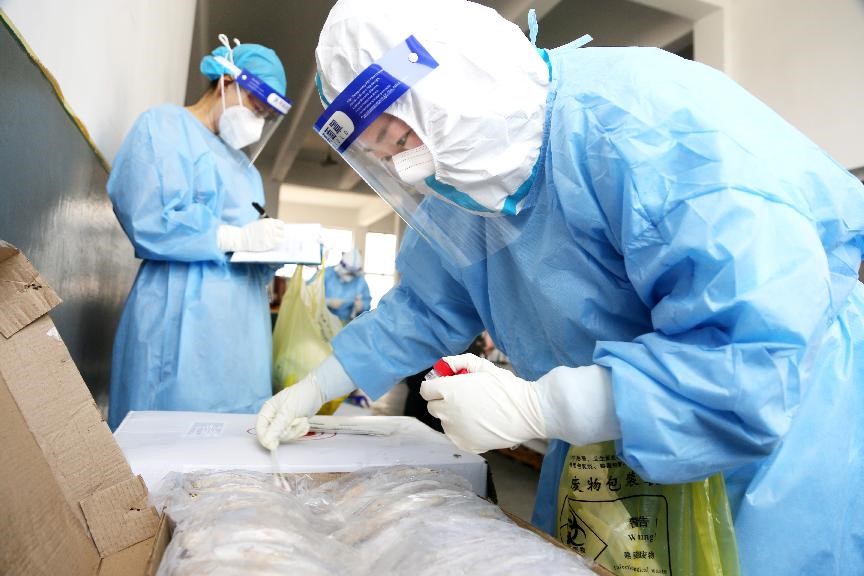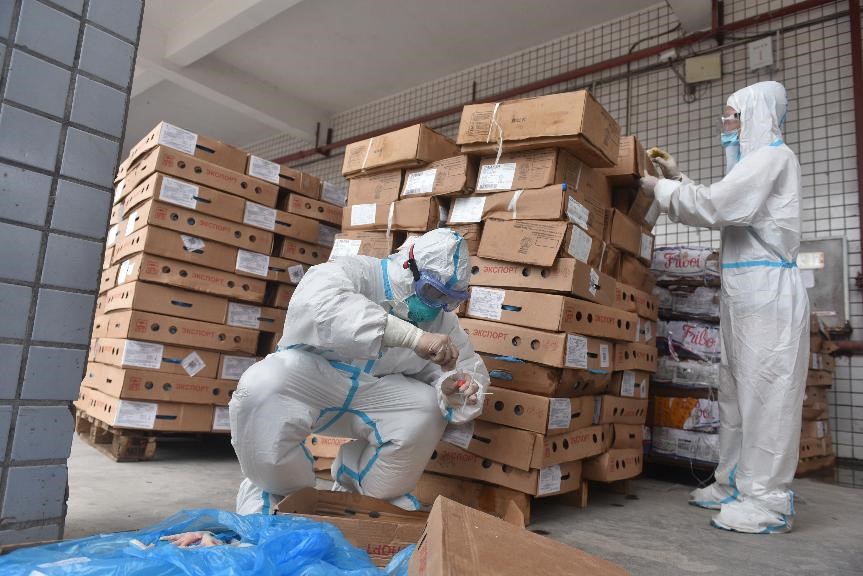Origin tracing studies into cold-chain transmission of COVID-19 necessary

A medical worker takes samples on imported fish for COVID-19 nucleic acid test at a refrigeration house in Lianyun district, Lianyungang, east China's Jiangsu province, Aug. 11, 2021. (Wang Chun/People's Daily Online)
Cold-chain products hold vital clues to the origins of COVID-19, and it's very necessary to launch global studies into the cold-chain transmission of the novel coronavirus, says an epidemiologist.
Such point of view echoes with a joint WHO-China study, which says the virus can be carried long distances on cold-chain products.
Some of the earliest cases detected in Wuhan in December 2019 were linked to the Huanan Seafood Market, where many shops were selling imported cold-chain products, and coincidently, investigations found that imported cold-chain products were also the sources of the viruses in the COVID-19 resurgences in Beijing, Dalian and Qingdao last year.
Studies indicate that the novel coronavirus can exist for weeks and even months in an environment with a temperature between -1℃ and -10℃, and survive for years when temperature falls to -60℃.
"Transmission routes of COVID-19 are diverse. It can be transmitted through physical contacts, as well as aerosols and droplets, and even contaminated matters," said Ma Huilai, director of the Chinese Field Epidemiology Training Program under the Chinese Center for Disease Control and Prevention (CDC), warning that contaminated packages of cold-chain products might become a hidden route for virus transmission.
Cold-chain products are generally stored and transported in low temperature, which offers favorable conditions for the long-term existence of the novel coronavirus and constitutes a major way of transmission, Ma noted.
The COVID-19 resurgence in Qingdao last October was an example, he said. Prior to COVID-19 cases resurged in the city, there had been five months during which none COVID-19 case was reported.
According to Ma, the first two patients in Qingdao were material handlers moving cold-chain products who had no history of traveling to other provinces or hospitalization. They had no contact with foreign ship crew members whose nucleic acid tests showed negative. The only possible scenario of infection was that they handled imported frozen gadus. Later, a high viral load was detected in samples of the gadus, and the genetic sequence of the virus carried by the two patients was identical with that on the packages of the frozen gadus.
In the first half of 2020, a number of enterprises around the world engaged in businesses relevant to cold-chain products reported COVID-19 cases. These cases repeatedly proved that the virus can be carried long distances on cold-chain products. Therefore, the COVID-19 cases in Wuhan's Huanan seafood market were very likely caused by imported cold-chain products.
The expert team that conducted the joint WHO-China study launched an investigation into the imported cold-chain products at the Huanan seafood market and markets in downtown Wuhan. According to Liu Jun, a researcher with the CDC and a member of the expert team, the ratio of infections at the shops selling imported cold-chain products was much higher than that at other shops, and the infection risk at these shops was 3.3 times higher.

Medical workers take samples on food packages for nucleic acid test at a warehouse for imported cold-chain products in Neijiang, southwest China's Sichuan province, Aug. 10, 2021. (Huang Zhenghua/People's Daily Online)
All the earliest three patients at the Huanan seafood market were directly engaged in businesses relevant to imported cold-chain products, and 16 of the 21 shops where the novel coronavirus was sampled sold imported cold-chain products or were engaged in relevant businesses.
Liu said blood samples obtained before December 2019 in some countries were tested positive for antibodies against the novel coronavirus, which meant COVID-19 infections might have happened at that time. Some of the cold-chain products sold at the Huanan seafood market came from these countries.
Besides, it is reported that horseshoe bats in some countries carry viruses similar to the novel coronavirus, and some of the cold-chain products sold at the Huanan seafood market came from these countries, too. Therefore, Liu believes it is necessary to launch a global origin tracing study into the cold-chain industry.
Xu Wenbo, head of the National Institute for Viral Disease Control and Prevention under the CDC, noted that where COVID-19 cases were firstly discovered doesn't have to be the origin of the virus. Origin tracing of COVID-19 is an issue of science that calls for cooperation among global scientists, he said, adding that origin tracing in the cold-chain industry is of vital importance.
Liu said international cooperation is very much needed by the origin tracing studies into the imported cold-chain products sold at the Huanan seafood market in 2019. There were 678 shops at the market, and 390 of them sold cold-chain products that totaled over 400 types from 37 countries, he explained.
It is necessary to carry out cooperation with the countries where these products were imported, perform antibody test on the preserved blood samples of the people who then worked in the industry, and trace their medical records, so as to find more clues to the true origins of the novel coronavirus, Liu noted.
Photos
 Dance show saluting traditional culture of the Song Dynasty makes its debut
Dance show saluting traditional culture of the Song Dynasty makes its debut Village in SW China’s Yunnan embraces prosperity through agricultural tourism
Village in SW China’s Yunnan embraces prosperity through agricultural tourism Eighth birthday for pair of giant pandas celebrated in Haikou, Hainan province
Eighth birthday for pair of giant pandas celebrated in Haikou, Hainan province Olympic gold medalists portrayed in Shanxi artist’s polymer clay sculptures
Olympic gold medalists portrayed in Shanxi artist’s polymer clay sculptures
Related Stories
- Tracing the origins of US media’s disinformation campaign against China on COVID-19
- Over 2.08 bln doses of COVID-19 vaccines administered in China
- Pakistan opposes politicizing COVID-19 origins tracing, urges science-based cooperation
- Virus origin tracing by intelligence community is a failed US conspiracy
- Chinese mainland reports no new locally transmitted COVID-19 cases
Copyright © 2021 People's Daily Online. All Rights Reserved.






